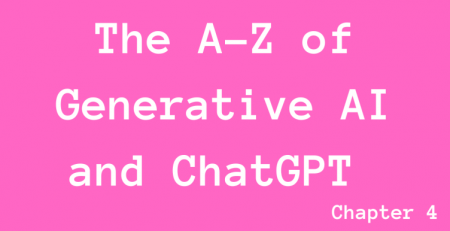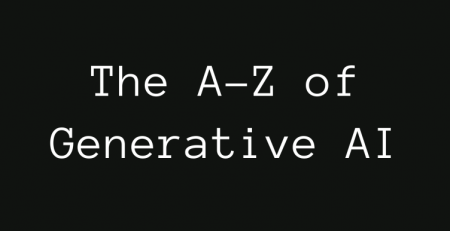The A-Z of Generative AI and ChatGPT – Chapter R
The rapid rise of generative AI is creating new risks and regulatory challenges for businesses, governments, and regulators worldwide. Teachers, business leaders, regulators and educators need to prioritize ethical and responsible AI, given the critical significance of Generative AI.
As we look towards the future, proficiency in AI is projected to be among the most sought-after skills, extending to everyone in the world of work and government. Understanding the nuances of AI technologies is a paramount skill for current and future generations.
Elevate your professional efficiency, marketability, and organizational success by delving into this meticulously crafted series on Generative AI.
Thank you for reading my latest article on AI and Generative AI risks. Here at LinkedIn and at Kieran Gilmurray, I regularly write about AI, Data Analytics, RPA, and Intelligent Automation.
To read my future articles, join my network by clicking ‘Follow‘. Also, feel free to connect with me via LinkedIn, Kieran Gilmurray, Calendly, Twitter, YouTube, Spotify or Apple Podcasts or read my latest book The A-Z of Organizational Digital Transformation, to learn more.
What Are Others Saying About Gen AI?
“As a CEO considering the implementation of Generative AI in your business, it’s important to approach this powerful technology with a balanced understanding of its potential and risks. Generative AI, while offering remarkable capabilities in content creation and process automation, is not without its challenges.
Therefore, implementing Generative AI requires a strategic approach involving technological integration and a thorough understanding of its implications on your business model, customer relations, and regulatory compliance. The key is to leverage its strengths while being acutely aware of its limitations and responsibly managing them.”
– Kieran Gilmurray (author)
AI and Generative AI Risks
There is risk in everything we do in life, and AI is no different. In an age where AI and generative AI are becoming integral to business operations, CEOs and business leaders must understand and mitigate the associated risks.
This chapter delves into four strategies for reducing AI risks: transparency, ethical AI maturity models, and explainable AI (XAI). It’s vital to navigate these challenges proactively, ensuring that AI is used responsibly and effectively to gain its benefits and minimize AI risks.
1. Transparency
Transparency can often be used interchangeably with “explainability” – it helps people understand why particular decisions are made and what factors are responsible for a model’s predictions, recommendations, or outputs.
Transparency also means being upfront about how and why you use data in your AI systems. Being clear and upfront about these issues builds trust, ensuring everyone is on the same page and fostering confidence in AI-driven experiences.
- What it means for customers: When your customers can trust and understand AI-driven decisions and how their data is used, they’ll have increased confidence in your products or services.
- What it means for teams: Teams can better explain and justify AI-driven decisions, improving stakeholder trust and reducing the risk of backlash within the organization.
2. Ethical AI maturity model
An Ethical AI maturity model is a framework that helps organizations assess and enhance their ethical practices in using AI technologies. It maps out how organizations can evaluate their ethical AI practices and then progress toward more responsible and trustworthy AI usage. It covers transparency, fairness, data privacy, accountability, and prediction bias issues.
- What it means for customers: Having an ethical AI model and being open about how you use AI helps build trust and assures your customers that you are using their data responsibly.
- What it means for teams: Regularly evaluating your AI practices and staying transparent about how you use AI can help you stay aligned with your company’s ethical considerations and societal values.
3. Explainable AI (XAI)
Remember being asked to show your work in math class? That’s what we’re asking AI to do. Explainable AI (XAI) should provide insight into what influenced the AI’s results, which will help users interpret (and trust!) its outputs. This kind of transparency is always important, particularly when dealing with sensitive systems like healthcare or finance, where explanations are required to ensure fairness, accountability, and, in some cases, regulatory compliance.
- What it means for customers: If an AI system can explain its decisions in a way that customers understand, it increases reliability and credibility. It also improves user trust, particularly in sensitive areas like healthcare or finance.
- What it means for teams: XAI can help employees understand why a model made a certain prediction. Not only does this increase their trust in the system, but it also supports better decision-making and can help refine the system.
4. Legislation
There are increasing calls for legislation that addresses the risks posed by artificial intelligence, and we are starting to see more appear. On both sides of the Atlantic, regulation is progressing at a much slower pace than the speed of AI advancement—and no significant global jurisdiction currently has rules in place that would force AI companies to meet a specified level of safety testing before releasing their models to the public.
The United States
For example, the Biden Administration has issued a “blueprint for an AI bill of rights” which welcomes AI-driven progress in science and health but says AI should not exacerbate existing inequalities, discriminate, impact privacy, nor act against people without their knowledge. But the blueprint is not legislation, or is it legally binding. The guidelines are instead a call to action for safeguarding digital and civil rights in an AI-fuelled world.
Blueprint for an AI Bill of Rights | OSTP | The White House
The European Union
The European Union proposed an Artificial Intelligence (AI) regulatory framework called the Artificial Intelligence Act. The draft AI act is among the first attempts to enact a horizontal regulation for AI, focusing on the specific utilization of AI systems and associated risks.
The proposed legal framework has been said to establish a technology-neutral definition of AI systems in EU law. It lays down a classification for AI systems with different requirements and obligations tailored to a ‘risk-based approach.’
For example, AI systems presenting ‘unacceptable’ risks would be prohibited. In contrast, a wide range of ‘high-risk’ AI systems would be authorized but subject to requirements and obligations to gain access to the EU market.
Those AI systems presenting only ‘limited risk’ would be subject to very light transparency obligations.
Both are examples of attempts to manage the tricky landscape of AI risk. Still, AI’s risk will remain significant unless there is a concerted global effort, much like the proliferation of nuclear arms treaty. Navigating this landscape requires a balanced approach that prioritizes ethical considerations and transparency.
While legislation is still catching up with AI advancements, CEOs, business leaders, model developers, regulators, and governments are responsible for implementing practices that safeguard customer trust and protect society. By embracing transparent, ethical, and explainable AI practices, they can lead their organizations towards a future where AI is powerful, trusted, and beneficial for everyone whilst we await further regulation and guidance.
Keen to learn more❓ Then keep reading.
Letter R
Understanding the A-Z of Generative AI opens up a rich world of possibilities for business leaders. The concepts below provide valuable insights into how AI can create new content, solve problems, and drive innovation across various industries.
1. Reinforcement Learning in Generative AI 🆁
Reinforcement Learning in Generative AI is a training technique where models learn by receiving feedback in the form of rewards for their generated content. Think about training an AI to be somewhat like teaching your pet a new trick. Your pet is the AI model, the pet trainer is the algorithm, and you are the pet owner.
With reinforcement learning, the AI, like a pet, tries different approaches. When it gets it right, it gets a treat or reward from the trainer, and when it’s off the mark, it’s corrected.
Over time, by understanding which actions lead to rewards and which don’t, it gets better at its tasks. Then, you as the pet owner, can give more specific feedback, making the pet’s responses refined to your house and lifestyle.
For Example: An AI language model receives rewards for generating accurate and helpful responses in a conversational setting.
Prompt: “ChatGPT, embrace reinforcement learning to improve your content generation skills, learning from positive feedback to provide more valuable responses.”
2. Regularization in Generative AI 🆁
Regularization in Generative AI is a technique used to prevent overfitting and enhance the generalization ability of AI models. It’s like balancing different aspects to avoid extreme behaviours. Regularization ensures that AI-generated content remains coherent and relevant, even when presented with new data.
For Example: An AI image generator uses regularization to produce photorealistic images that are neither too noisy nor too bland.
Prompt: “Apply regularization techniques to maintain the quality and consistency of your content generation, avoiding overly specific or ambiguous responses, and create the photorealistic image of a young child on a swing in the back garden of a suburban house.”
3. Recurrent Neural Networks (RNNs) in Generative AI 🆁
Recurrent Neural Networks (RNNs) in Generative AI are a class of neural networks designed to handle sequential data. It’s like an AI that can remember past events to understand the present context better. RNNs are valuable for tasks involving natural language generation and time-series data.
For Example: An AI language model based on RNNs generates coherent paragraphs, considering the context of preceding sentences.
Prompt: “Leverage the power of Recurrent Neural Networks to improve your language generation, creating contextually connected responses.”
4. Reinforcement Learning from Human Feedback (RLHF) in Gen AI 🆁
Reinforcement Learning from Human Feedback (RLHF) is a technique where AI models learn from the feedback provided by humans on their generated content. It’s like students learning from a teacher’s corrections. RLHF helps AI models refine their responses based on human evaluations.
For Example: An AI chatbot collects user feedback and adjusts its responses based on the perceived quality.
Prompt: “Cengage in Reinforcement Learning from human feedback to continually improve your content generation, learning from human evaluators.”
5. Rejection Sampling in Generative AI 🆁
Rejection Sampling in Generative AI is a method to generate high-quality samples by rejecting low-quality ones. It’s like selecting only the best artworks from a collection. Rejection sampling ensures that AI-generated content meets specific criteria, improving overall content quality.
For Example: An AI artist generates various art pieces but selects only the most aesthetically pleasing ones for exhibition.
Prompt: “Employ rejection sampling techniques to produce content that meets high standards of quality, offering valuable and relevant responses.”
6. Robustness in Generative AI 🆁
Robustness in Generative AI refers to the ability of AI models to perform well and generate meaningful content even in the presence of noisy or unexpected input. It’s like an athlete staying focused despite distractions. Robustness ensures that AI models provide consistent and accurate responses.
For Example: An AI language model remains reliable even when faced with input containing spelling errors or typos.
Prompt: “Develop a comprehensive business strategy report on enhancing ‘Robustness in Generative AI’ within your company’s AI initiatives. Begin with an executive summary that introduces the concept of robustness in AI, drawing an analogy to an athlete maintaining focus amid distractions. The first section should explore the importance of robust AI models in business, emphasizing how they ensure consistent and accurate responses even when faced with noisy or unexpected data. Proceed with an analysis of current industry standards and benchmarks for robustness in AI, including examples of AI models that are known for their resilience.
The next section should detail the challenges faced in achieving robustness, such as data variability and model overfitting, and how these can impact business operations. Follow this with strategic recommendations on how to improve the robustness of your AI models, including data management practices, model testing scenarios, and continuous monitoring and updating mechanisms.
Conclude with a forward-looking perspective, discussing emerging technologies and methodologies that could further enhance AI robustness. Ensure the report includes data-driven insights, case studies, and actionable steps tailored to your company’s specific context and needs.”
7. Rule-Based Approaches in Generative AI 🆁
Rule-Based Approaches in Generative AI involve using predefined rules or patterns to generate content. It’s like following a set of instructions to solve a problem. Rule-based approaches are helpful when generating structured content with specific patterns or formats.
For Example: An AI system uses rule-based approaches to generate code snippets following programming syntax.
Prompt: “ChatGPT, explore rule-based approaches to generate structured content, adhering to specific guidelines and patterns as required.”
8. Representation Learning in Generative AI 🆁
Representation Learning in Generative AI involves learning meaningful and compact representations of input data. It’s like summarizing a long story into a few key points. Representation learning enables AI models to understand the underlying patterns and features of data, leading to more efficient and accurate content generation.
For Example: An AI image generator learns to represent images as latent vectors, facilitating high-quality image synthesis.
Prompt: “ChatGPT, focus on representation learning to understand data better and improve your content generation with meaningful and concise responses.”
9. Recurrent Generative Models 🆁
Recurrent Generative Models are a class of AI models that use feedback loops to generate content, considering context from previous steps. It’s like composing music with each note influenced by the melody’s past elements. Recurrent generative models excel in generating sequential content, such as text and music.
For Example: An AI language model based on recurrent generative models generates coherent and context-aware conversational responses.
Prompt: “ChatGPT, harness the power of recurrent generative models to improve your language generation, producing contextually coherent and engaging responses.”
10. Real-Time Content Generation 🆁
Real-Time Content Generation involves the ability of AI models to generate content instantaneously, providing immediate responses to user queries. It’s like having a quick-witted assistant who responds without delay. Real-time content generation ensures efficient and seamless interactions with AI systems.
For Example: An AI-powered virtual assistant generates real-time responses to user requests, providing immediate answers to questions.
Prompt: “ChatGPT, aim for real-time content generation to provide instant and timely responses, making interactions with users more effective and efficient.”

Generative AI will impact every single role you can think of. Understanding how to interact with ChatGPT will soon be an essential key skill. Below are five roles that begin with the letter R with an example prompt, each massively boosting role productivity.
Research Scientist. Research scientists conduct scientific experiments and investigations to advance knowledge in their field.
Risk Analyst. Risk analysts assess potential risks and their impact on businesses and financial institutions.
Registered Nurse. Registered nurses provide patient care, administer medications, and advocate for patients’ well-being.
Recruitment Specialist. Recruitment specialists are responsible for finding and hiring the best talent for organizations.
Real Estate Agent. Real estate agents help clients buy, sell, or rent properties, representing them in real estate transactions.

Some of the best Generative AI articles from some of the best sources on the internet.

Need help understanding Generative AI and how it applies to your business ❓
Then book a FREE 30 minute introductory call so we can discuss your specific Data Analytics, Artificial Intelligence and Generative AI needs today – click here.

Who am I❓
I am a senior executive with 28+ years of experience leading digital programs and the author “The A-Z of Organizational Digital Transformation.” I have been a director, board member, research fellow, and advisor to multiple international companies.
Find me on social LinkedIn | Kieran Gilmurray | Twitter | YouTube | Spotify | Buzzsprout

I am regularly ranked as one of the top global experts in Artificial Intelligence, Intelligent Automation, Data Analytics, Brand Influence, and Business Technology Innovation and have won multiple international awards, including:
🔹Seven Times LinkedIn Top Voice
🔹Top 14 people to follow in data in 2023
🔹Top 20 Data Pros you NEED to follow
🔹World’s Top 200 Business and Technology Innovators
🔹Global Automation Award Winner
🔹Top 50 Intelligent Automation Influencers
🔹Top 50 Brand Ambassadors

I am a hugely experienced data science leader who has led teams of Ph. D.s, data analysts, data engineers, and database administrators for many years, creating one of the few genuine decision intelligence companies to date along the way.
But don’t just take my word for it.

‘Kieran is an exceptional technologist and automation expert, skilled at AI, data analytics, and decision insight. His business and technical knowledge are second to none. If you or your business want to achieve your goals, connect with Kieran.’
Pascal Bornet. Top Voice in Tech, Best Selling Author, AI & Automation Expert and Forbes Technology Council Member

To stay on top of the latest news on Generative AI, Data Analytics, or emerging tech trends, make sure to subscribe to visit my website, follow me on Twitter, LinkedIn, Spotify and YouTube, and check out my best-selling book ‘The A-Z of Organizational Digital Transformation’ or book a free 30 call to chat on your business, AI, Generative AI, Intelligent Automation or Data Analytics needs.
👏 Thank you for reading to the end.











Leave a Reply